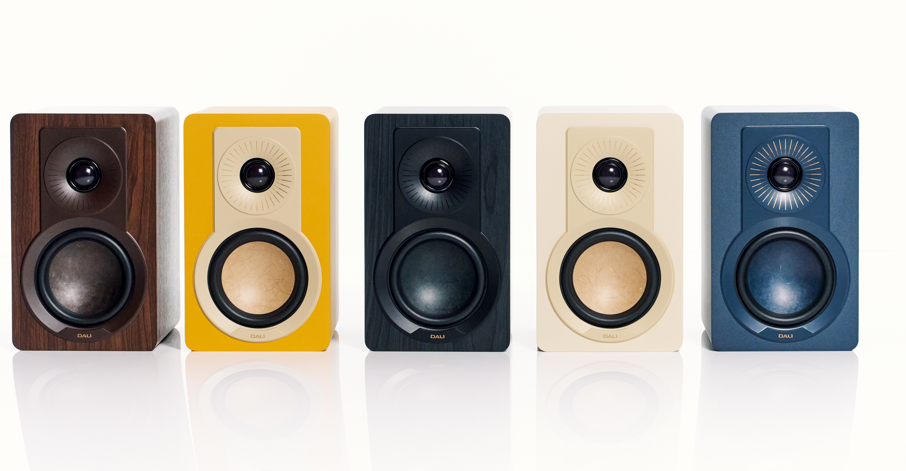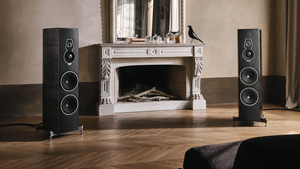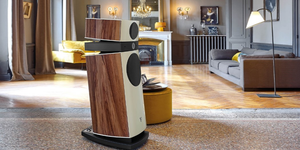
DALI KUPID Review: A Shot of Adrenaline for Budget Hi-Fi
In a world of beige boxes, DALI's vibrant new bookshelf speakers aim to make you fall in love with music all over again. Do they hit the mark?
Introduction: Death to Boring Hi-Fi?
Take a stroll through the landscape of entry-level high-fidelity audio, and you’ll quickly notice a prevailing aesthetic. It is a sea of black and walnut boxes, a respectable but conservative fleet of speakers that prioritizes sonic value over visual excitement. For decades, the implicit agreement has been that at the budget end of the market, your investment should be heard, not seen. But in an age where design permeates every aspect of our lives, from our phones to our coffee makers, one has to ask: has affordable hi-fi become too monotonous for modern living spaces?
Into this world of muted tones steps the DALI KUPID, a speaker that feels less like a component and more like a statement. It arrives like a "breath of fresh Scandinavian air," unapologetically championing color, style, and personality. This is not just another box; it's a vibrant antidote to the audio world's beige conformity. The Danish manufacturer, DALI (Danish Audiophile Loudspeaker Industries), has a long-standing reputation for engineering speakers that punch well above their weight, but the KUPID feels like a new declaration of intent. As Krestian Pedersen, DALI's Head of Product Management, puts it, the KUPID is "about simplicity and sound... It's for anyone who wants a real Hi-Fi experience without any fuss... about falling in love with music again".

This mission is significant. The KUPID is not a niche side project; it is the designated successor to the brand's highly regarded Spektor series, tasked with establishing a new entry-level benchmark for a new generation of listeners. The promise is ambitious: to take the sonic DNA of DALI's high-end flagships and distill it into a "smaller, more approachable package ideal for modern living spaces". The goal is to make "real Hi-Fi accessible to more people" by stripping away the unnecessary and focusing on what truly matters: sound quality, build integrity, and aesthetic appeal.
This raises the central question of our review. In its bold and admirable pursuit of a younger, more style-conscious audience, has DALI created a product that successfully marries form and function? Or, in its quest to stand out visually, have sonic compromises been made that might give the traditional budget audiophile pause? It’s time to find out if this is a true love match or merely a fleeting infatuation.

Design and Build: Scandinavian Chic Meets Real-World Practicality
From the moment you unbox the DALI KUPID, it's clear this is a speaker designed with a modern sensibility. It eschews the sharp-edged, utilitarian look of many rivals in favor of a "compact, appealing design" with smooth curves and a neat, clean finish that feels both contemporary and inviting.
Aesthetics and First Impressions
The most striking feature is, of course, the color palette. While traditional Black Ash and Walnut veneers are available for those who prefer a classic look, DALI makes a bold statement with Caramel White, Golden Yellow, and Chilly Blue. These are not mere afterthoughts; they are central to the KUPID's identity, designed to inject a "youthful, lively identity" into a room rather than simply blend in. The attention to detail is impressive. DALI has gone to the trouble of color-matching the mid-woofer cones to each finish, a "nice touch" that adds a layer of design cohesion, especially for those who prefer to listen with the grilles off. The included textured magnetic grilles are also color-matched, ensuring a clean, Scandinavian aesthetic whichever way you choose to display them.

Living with Kupid: Unmatched Versatility
Beyond aesthetics, the KUPID is a masterclass in practical, real-world design. Its diminutive dimensions are a key part of its charm. Measuring just 23.7 cm high, 14 cm wide, and 19.5 cm deep (9.3 x 5.5 x 7.6 inches), it has a tiny footprint that makes it incredibly easy to place. This is a speaker designed for the way people actually live—in apartments, offices, dorm rooms, and multi-use living spaces where a pair of hulking standmounters is simply not an option.
DALI has leaned into this versatility by including a generous set of accessories right in the box. You get not only rubber feet for stable placement on a desk or shelf but also a full set of brackets and screws for wall-mounting. This is a rare and welcome inclusion at this price point, and it directly supports DALI's stated goal of creating a speaker that is "easy to live with" and "at home in all listening and living scenarios".

The Build Quality Question: A Calculated Compromise
While the finish is neat and the design is chic, picking up the KUPID reveals its one potential point of contention. The cabinet feels "lightweight". In a direct comparison with its arch-rival, the Wharfedale Diamond 12.1, the KUPID's build can feel "quite 'budget'". The Wharfedale is described as "reassuringly solid" and "sturdier," with a more refined and substantial wood finish. This might initially seem like a straightforward win for the Wharfedale. However, a deeper analysis suggests this is not a design flaw but a deliberate and intelligent engineering trade-off.
At a highly competitive price point of around £299 / $600, manufacturers cannot afford to excel in every single area; they must make strategic decisions about where to allocate the budget. The Wharfedale 12.1 clearly invests heavily in its cabinet, using differing thicknesses of MDF and strategic bracing to control resonance. DALI appears to have taken a different path. The detailed descriptions of the KUPID's internal components—the proprietary wood fiber cone, the custom-developed tweeter, the in-house designed crossover—indicate that these are high-performance, and likely high-cost, items. This is the core "DALI DNA" that the company was unwilling to compromise on.
Therefore, the most logical area for cost savings is the cabinet construction. By opting for a simpler, less massive enclosure, DALI has freed up the budget to invest in the components that are most critical to its signature sound. The consumer is presented with a clear choice. With the KUPID, your money is buying a sophisticated "engine" (the drivers and crossover) and a premium "paint job" (the stylish, colorful finishes), rather than a heavy-duty "chassis" (the cabinet). This is a classic "sound-first" engineering philosophy, and understanding it is crucial to appreciating the KUPID's true value proposition.

Under the Hood: The DALI Sonic DNA
Despite its lightweight cabinet and accessible price tag, the technology inside the DALI KUPID is serious business. This is a speaker that is, as the company proudly states, "100% DALI, proudly designed and engineered in-house in Denmark". It inherits its core acoustic principles directly from the brand's far more expensive high-end models.
The Mid-Woofer
At the heart of the KUPID's sound is the proprietary 4.5-inch (114mm) mid-bass driver. The cone is crafted from DALI's signature blend of paper and wood fibers, a material chosen for its unique combination of low mass, high rigidity, and self-damping properties. The goal of this design is to achieve a fast, precise, and "colorless" response, allowing for the reproduction of natural warmth and clarity in vocals and instruments. This driver is powered by a large ferrite magnet system and features a low-loss rubber surround, components designed to ensure tight, controlled bass and a dynamic midrange—hallmarks of the DALI house sound. Notably, the magnet system is described as being unusually large for a speaker in this price range, a key factor in the KUPID's surprising dynamic capabilities.
The Tweeter
Handling the high frequencies is a custom-developed 26mm (1-inch) ultra-light soft dome tweeter. DALI's engineers designed this unit specifically to deliver detailed and extended highs with minimal distortion and a smooth, wide dispersion pattern. A crucial element of its design is the specially shaped tweeter baffle. This waveguide is carefully engineered to control the tweeter's dispersion, widening the "sweet spot" and creating a more uniform and expansive soundstage. This makes the KUPID less fussy about precise listening position, a significant advantage in the real-world living spaces for which it is intended.
Crossover and Cabinet Integration
The "brain" of the speaker is its custom crossover network. This circuit is tasked with seamlessly blending the output of the two drivers, and DALI has designed it with a focus on "timing accuracy, soft roll-off, and exceptional clarity". The goal is to ensure both drivers work in perfect harmony, creating a cohesive and natural sonic whole.
This integrated system is housed in a cabinet featuring a rear-firing "dual flare" bass reflex port. Unlike a simple tube, this port is flared at both the internal and external openings. This design optimizes airflow, reducing turbulence and the "organ pipe" resonances that can muddy the bass response in less sophisticated designs. The result is cleaner, deeper, and more articulate bass than one would typically expect from such a compact enclosure, allowing the KUPID to sound fuller and more balanced than its small size would suggest.

Table 1: DALI KUPID - Full Technical Specifications
| Feature | Specification |
| Type | 2-way Standmount/Bookshelf |
| Enclosure Type | Bass Reflex (rear-ported, dual flare) |
| Mid/Bass Driver | 4.5-inch (114mm) paper and wood fiber cone |
| Tweeter | 1-inch (26mm) soft dome |
| Frequency Response (±3 dB) | 63Hz – 25kHz |
| Sensitivity (2.83V/1m) | 83dB |
| Nominal Impedance | 4 ohms |
| Recommended Amplifier Power | 40W – 120W |
| Dimensions (HWD) | 23.7 x 14 x 19.5 cm / 9.3 x 5.5 x 7.6 inches |
| Weight (per speaker) | 2.9 kg |
| Finishes | Black Ash, Walnut, Caramel White, Golden Yellow, Chilly Blue |
| Included Accessories | Magnetic Grilles, Wall Brackets, Rubber Feet |
Sound Performance: An Infectious Sense of Fun
If the KUPID’s design is a visual delight, its sonic performance is an outright party. This is not a speaker that aims for sterile, analytical neutrality. Instead, it delivers a performance that is consistently described as "lively, entertaining and rhythmically agile". The defining characteristic that runs through every aspect of its sound is a "sheer sense of fun"—a nimble, detailed, and punchy presentation that is immediately engaging and musically compelling.

Rhythm, Timing, and Agility (The "PRaT" Factor)
The KUPID's greatest strength, and its most significant point of differentiation from its rivals, is its phenomenal handling of rhythm and timing. It possesses a "fleet-footed quality that zips along with all kinds of tracks in an engaging manner". This isn't just about being fast; it's about being articulate and coherent, with an uncanny ability to start and stop on a dime.
Playing the complex, high-octane track "Starburster" by Fontaines D.C., the KUPID's alacrity is on full display. The "punctuating gasps in the chorus" are rendered with razor-sharp precision, stopping and starting with an agility that keeps the track's frenetic energy perfectly intact. On Rag'n'Bone Man's "Human," the focus is on the propulsive bassline. While other small speakers might struggle to convey its weight, the KUPID renders it as "tuneful and agile enough to keep the track's fierce momentum going," prioritizing rhythmic drive over sheer brute force. The effect is infectious. Spinning a classic like Dr. Dre's "Still Dre," it's almost impossible not to "tap our toes and snapping our fingers along to the melody." The KUPID's "infectious sense of enthusiasm and stellar sense of timing" hooks you into the groove and never lets go.
Midrange and Vocals: The Soul of the Music
This rhythmic prowess is built upon a foundation of an exceptionally expressive and solid midrange. This is where the soul of the music resides, and the KUPID communicates it with a clarity and focus that is remarkable at this price. Vocals, in particular, are a standout strength. Listening to Laura Marling's "Hope In The Air," her strong yet intimate voice is communicated with "crystal clear focus," laying bare "all the nuances and emotion in her singing". This ability to convey the subtle textures and emotional weight of a performance makes the KUPID exceptional for acoustic, folk, and vocal-centric music.
Dynamics and Punch
For such a small speaker, the KUPID delivers a surprisingly "dynamic, detailed and punchy" sound. It excels at conveying the musical ebb and flow of a track with conviction, from large-scale shifts to more subtle micro-dynamic moments. On a track like Kendrick Lamar's "King Kunta," the KUPID has enough slam in the lower frequencies to provide a solid, energetic underpinning. While it may not shake the room, it delivers a "satisfying amount of punch that keeps us entertained" and ensures that music has impact and vitality.

Bass, Treble, and Overall Balance
Of course, a speaker of this size comes with inherent physical limitations. The bass "doesn't go as deep as some" rivals, and it won't deliver the kind of subterranean rumble that larger speakers can. However, the bass it does produce is of excellent quality: it's tuneful, agile, and completely free of the "flab at the bottom" that can plague lesser budget designs. At the other end of the spectrum, the treble is open and detailed but is carefully tuned to avoid any "undue brashness at the top". The result is a cohesive and well-balanced presentation that allows the personality and tone of each recording to shine through.
This sonic signature is no accident. In designing a small, affordable speaker, engineers face a choice. They could have used port tuning or digital signal processing tricks to try and force deeper bass out of the small cabinet. However, this approach often comes at the cost of speed and precision, resulting in a slow, "boomy" sound that smears rhythmic detail. The KUPID's celebrated "snappy timing" and "agile rhythm" strongly suggest that DALI's engineers deliberately chose a different path. They embraced the natural strengths of a small, fast driver—speed, control, and agility—and voiced the speaker to maximize these qualities. This "fun factor" is not a by-product of its design; it is the core of its philosophy. It is a speaker intentionally engineered to connect the listener to the energy and emotion of the music, perfectly aligning with DALI's mission to help people "fall in love with music again".

Soundstage and Limitations
The trade-offs for this energetic performance are predictable and honestly presented. The soundstage, while coherent, is not as "wide as some" of its larger competitors. And when pushed to party levels in a large room, the diminutive KUPIDs can "start to complain just a little". These are not speakers designed to fill a cavernous space with thunderous sound. They are best suited for small to medium-sized rooms, where these limitations are far less apparent and their many talents can truly come to the fore.
Compatibility and Setup: The Unfussy Performer
One of the DALI KUPID's most compelling attributes is how easy it is to live with. It is an unfussy performer that is designed to sound great without requiring the perfect room or a perfectly matched, high-end amplifier.
Placement Flexibility
Many bookshelf speakers, particularly those with rear-firing bass ports, are notoriously sensitive to placement. Position them too close to a wall, and the bass can become boomy and overwhelming. The KUPID, however, has been specifically engineered to mitigate this issue. Its acoustic design allows it to perform exceptionally well even when placed just an inch or two from a rear wall, a significant real-world advantage for anyone who doesn't have the luxury of placing their speakers far out into the room. This, combined with the included wall-mount brackets, makes the KUPID a true chameleon, able to adapt to almost any living space without a significant compromise in sound quality.
Amplifier Pairing: Decoding the Specs
A glance at the KUPID's specifications might present a puzzle to the budding audiophile. It has a low sensitivity rating of just 83dB, which typically suggests that a powerful amplifier is needed to achieve satisfying volume levels. However, this is paired with a stable 4-ohm nominal impedance, which DALI notes presents a consistent and "easy to drive" load for an amplifier.
This combination of specifications is not a contradiction; rather, it reflects a design that is perfectly timed for the current audio market. The recent proliferation of affordable, high-quality, compact streaming amplifiers has fundamentally changed the system-matching equation. A new generation of powerful and clean-sounding Class D integrated amplifiers, such as the popular WiiM Amp Ultra or the Marantz M1, can be had for a modest outlay. These amplifiers provide more than enough clean wattage to overcome the KUPID's low sensitivity, allowing them to sing without strain. The KUPID's stable impedance ensures that these amplifiers can deliver their power cleanly and efficiently, without being taxed by difficult electrical loads.
This creates a synergistic and perfectly modern hi-fi system. The KUPID's electrical design is an ideal match for its most likely partners. Pairing these speakers with a compact streaming amplifier results in a minimalist, stylish, and remarkably high-performance system that delivers on the promise of "real Hi-Fi without any fuss". It is a combination that is highly recommended for anyone looking to build a first-class audio setup that fits seamlessly into a modern lifestyle.

Competitive Landscape: Fun vs. Refinement
No speaker exists in a vacuum, and the DALI KUPID enters one of the most hotly contested sectors of the hi-fi market. Its primary rival is the multi-award-winning Wharfedale Diamond 12.1, a speaker that has become the de facto benchmark for budget bookshelf performance. The choice between these two excellent speakers illuminates two distinct philosophies in affordable audio design.
The Main Event: vs. Wharfedale Diamond 12.1
The Wharfedale Diamond 12.1 is the champion of traditional hi-fi virtues. It presents a more mature and refined design, backed by a sturdier, more premium-feeling build quality that inspires confidence. Sonically, it offers a more composed and easy-going presentation. Its key strengths lie in its ability to create a spacious, wide soundstage and to deliver bass with more weight and impact than the smaller DALI. It is a wonderfully sophisticated and tonally smooth performer for the price.
The DALI KUPID, in contrast, is the energetic challenger. What it concedes in cabinet solidity and bass depth, it more than makes up for in sheer excitement. It is consistently described as the more "lively," "dynamically exciting," and "rhythmically agile" of the two. It punches harder, tracks rhythms with more snap and precision, and wins you over with its infectious sense of fun. This isn't a matter of one being definitively "better" than the other; it's a matter of priorities.

Table 2: DALI KUPID vs. Wharfedale Diamond 12.1 - At a Glance
| Category | DALI KUPID | Wharfedale Diamond 12.1 |
| Design Philosophy | Modern, Colourful, Compact | Traditional, Refined, Larger |
| Build Quality | Lightweight, "Budget" Feel | Sturdier, Solid MDF, Premium Feel |
| Sonic Character | Lively, Punchy, Rhythmically Agile | Composed, Refined, Easy-Going |
| Key Strengths | Midrange Expression, Timing, Fun Factor | Soundstage Space, Bass Impact, Refinement |
| Ideal Listener | Prioritizes engagement and energy in a modern, compact system. | Prioritizes a spacious, smooth sound and a premium build. |
Context within DALI's Lineup
Perhaps the most surprising feedback comes from early adopters, some of whom claim the KUPID sounds "better than the Spektor 2s and in my opinion Oberon 1". This is a significant claim, as the Oberon series sits a full tier above the KUPID in DALI's product hierarchy. While this should be treated as anecdotal user experience rather than a definitive lab finding, it is an intriguing piece of the puzzle. It suggests that the KUPID is not merely a cosmetic update to the old Spektor line but represents a genuine leap forward in performance for DALI's entry-level offerings, potentially disrupting the company's own carefully structured product ladder.
A Strategic Pivot to a New Audience
Ultimately, the comparison with Wharfedale reveals a deeper strategic play by DALI. The Diamond 12.1 is an evolution of a traditional hi-fi speaker, designed to appeal to the existing audiophile community. The DALI KUPID, with its entire package—the vibrant colors, the ultra-compact size, the extreme placement flexibility, and the perfect synergy with simple streaming amplifiers—is clearly aimed at a different, younger demographic that prioritizes aesthetics and convenience.
This is the audience that currently gravitates towards all-in-one "lifestyle" systems like Sonos or high-end Bluetooth speakers. By creating a product that competes with these systems on design and ease of use but delivers a demonstrably superior sonic experience, DALI is attempting to bridge the gap. The KUPID is a "Trojan Horse," designed to capture the lifestyle audio customer and introduce them to the richer, more rewarding world of component hi-fi. It is not just competing with Wharfedale; it is competing with Sonos for the hearts, minds, and ears of a new generation of music lovers. The KUPID is DALI's bold and brilliant answer to the changing landscape of how we consume audio at home.
Our Verdict
The DALI KUPID is a speaker that arrives on the scene with a clear and unapologetic sense of purpose. It is designed to be fun, stylish, and musically engaging above all else. It successfully rejects the notion that budget hi-fi has to be boring, delivering a package that delights both the eyes and the ears.
It is not the most forensically detailed, spacious, or deep-sounding speaker you can buy for the money. If your priorities lie with a substantial, premium-feeling build and a sound that values refinement and scale, its key rival from Wharfedale remains a formidable choice. But that is missing the point of what DALI has achieved here. The KUPID is a master of rhythm and a conduit of pure musical energy. Its ability to communicate the drive, emotion, and sheer joy of a performance is second to none at this level. It is a speaker that constantly reminds you why you fell in love with music in the first place.

FOR
Wonderfully lively, entertaining, and rhythmically agile sound
Expressive, clear, and detailed midrange
Dynamic and punchy presentation for its size
Compact, stylish design in a range of appealing colors
Highly flexible placement options, including wall-mounting
AGAINST
Build quality feels lightweight and "budget" compared to the best rivals
Bass lacks the ultimate depth and extension
Low sensitivity rating may concern some
Can sound strained when pushed to very high volumes in large rooms
The Definitive Recommendation
The DALI KUPID earns an enthusiastic, five-star recommendation, but with a specific listener in mind. If you are building a modern, stylish audio system for a small-to-medium-sized room, and you value musical energy, punch, and rhythmic engagement above all else, look no further. Paired with a quality compact streaming amplifier, it creates a simple, elegant system that delivers a performance far greater than the sum of its parts. It is the perfect first step for anyone looking to move beyond the limitations of soundbars and all-in-one wireless speakers.
For those in larger rooms, or for listeners who prefer a more traditionally refined, spacious sound and a more substantial build, rivals like the Wharfedale Diamond 12.1 remain an equally valid and excellent choice. The beauty of today's budget hi-fi market is that you can choose the flavor of performance that best suits your taste. If you feel your passion for music needs rekindling with a jolt of pure, unadulterated fun, DALI's Kupid is the perfect matchmaker.






Comments